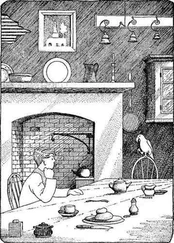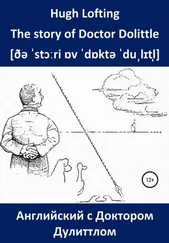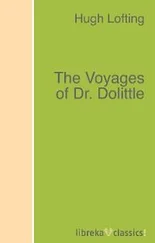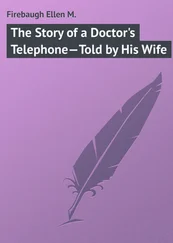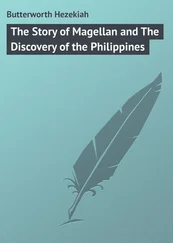Hugh Lofting - The Story of Doctor Dolittle
Здесь есть возможность читать онлайн «Hugh Lofting - The Story of Doctor Dolittle» весь текст электронной книги совершенно бесплатно (целиком полную версию без сокращений). В некоторых случаях можно слушать аудио, скачать через торрент в формате fb2 и присутствует краткое содержание. Год выпуска: 1996, Жанр: Сказка, на английском языке. Описание произведения, (предисловие) а так же отзывы посетителей доступны на портале библиотеки ЛибКат.
- Название:The Story of Doctor Dolittle
- Автор:
- Жанр:
- Год:1996
- ISBN:нет данных
- Рейтинг книги:3 / 5. Голосов: 1
-
Избранное:Добавить в избранное
- Отзывы:
-
Ваша оценка:
- 60
- 1
- 2
- 3
- 4
- 5
The Story of Doctor Dolittle: краткое содержание, описание и аннотация
Предлагаем к чтению аннотацию, описание, краткое содержание или предисловие (зависит от того, что написал сам автор книги «The Story of Doctor Dolittle»). Если вы не нашли необходимую информацию о книге — напишите в комментариях, мы постараемся отыскать её.
The Story of Doctor Dolittle — читать онлайн бесплатно полную книгу (весь текст) целиком
Ниже представлен текст книги, разбитый по страницам. Система сохранения места последней прочитанной страницы, позволяет с удобством читать онлайн бесплатно книгу «The Story of Doctor Dolittle», без необходимости каждый раз заново искать на чём Вы остановились. Поставьте закладку, и сможете в любой момент перейти на страницу, на которой закончили чтение.
Интервал:
Закладка:
THE STORY OF DOCTOR DOLITTLE

“A little town called Puddleby-on-the-Marsh”
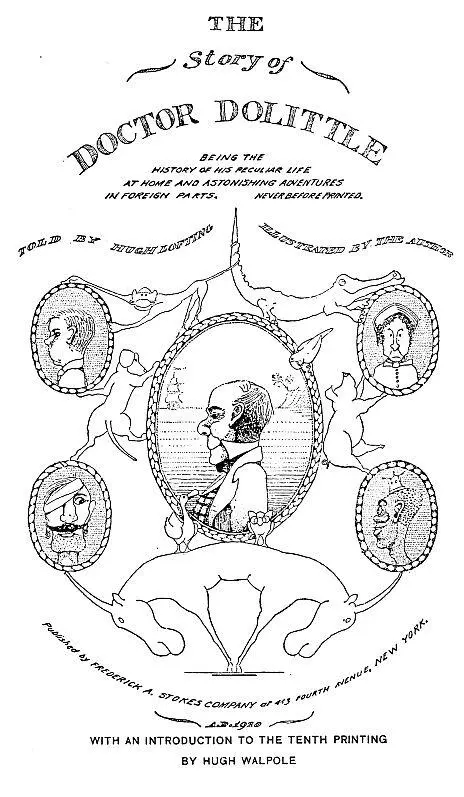
THE
Story of
DOCTOR DOLITTLE
BEING THE
HISTORY OF HIS PECULIAR LIFE
AT HOME AND ASTONISHING ADVENTURES
IN FOREIGN PARTS. NEVER BEFORE PRINTED.
TOLD BY HUGH LOFTING ILLUSTRATED BY THE AUTHOR
Published by FREDERICK A. STOKES COMPANY at 443 FOURTH AVENUE, NEW YORK.
A.D. 1920
WITH AN INTRODUCTION TO THE TENTH PRINTING
BY HUGH WALPOLE
Copyright, 1920, by
Frederick A. Stokes Company
All rights reserved, including that of translation
into foreign languages
First Printing, Aug. 24, 1920 Second Printing, Dec. 17, 1920 Third Printing, April 16, 1921 Fourth Printing, July 7, 1921 Fifth Printing, Sept. 1, 1921 Sixth Printing, Oct. 26, 1921 Seventh Printing, Dec. 5, 1921 Eighth Printing, April 3, 1922 Ninth Printing, Aug. 18, 1922 Tenth Printing, Nov. 28, 1922 Eleventh Printing, April 2, 1923
Printed in the United States of America
TO
ALL CHILDREN
CHILDREN IN YEARS AND CHILDREN IN HEART
I DEDICATE THIS STORY
INTRODUCTION TO THE TENTH PRINTING
THERE are some of us now reaching middle age who discover themselves to be lamenting the past in one respect if in none other, that there are no books written now for children comparable with those of thirty years ago. I say written for children because the new psychological business of writing about them as though they were small pills or hatched in some especially scientific method is extremely popular to-day. Writing for children rather than about them is very difficult as everybody who has tried it knows. It can only be done, I am convinced, by somebody having a great deal of the child in his own outlook and sensibilities. Such was the author of “The Little Duke” and “The Dove in the Eagle’s Nest,” such the author of “A Flatiron for a Farthing,” and “The Story of a Short Life.” Such, above all, the author of “Alice in Wonderland.” Grownups imagine that they can do the trick by adopting baby language and talking down to their very critical audience. There never was a greater mistake. The imagination of the author must be a child’s imagination and yet maturely consistent, so that the White Queen in “Alice,” for instance, is seen just as a child would see her, but she continues always herself through all her distressing adventures. The supreme touch of the white rabbit pulling on his white gloves as he hastens is again absolutely the child’s vision, but the white rabbit as guide and introducer of Alice’s adventures belongs to mature grown insight.
Geniuses are rare and, without being at all an undue praiser of times past, one can say without hesitation that until the appearance of Hugh Lofting, the successor of Miss Yonge, Mrs. Ewing, Mrs. Gatty and Lewis Carroll had not appeared. I remember the delight with which some six months ago I picked up the first “Dolittle” book in the Hampshire bookshop at Smith College in Northampton. One of Mr. Lofting’s pictures was quite enough for me. The picture that I lighted upon when I first opened the book was the one of the monkeys making a chain with their arms across the gulf. Then I looked further and discovered Bumpo reading fairy stories to himself. And then looked again and there was a picture of John Dolittle’s house.
But pictures are not enough although most authors draw so badly that if one of them happens to have the genius for line that Mr. Lofting shows there must be, one feels, something in his writing as well. There is. You cannot read the first paragraph of the book, which begins in the right way “Once upon a time” without knowing that Mr. Lofting believes in his story quite as much as he expects you to. That is the first essential for a story teller. Then you discover as you read on that he has the right eye for the right detail. What child-inquiring mind could resist this intriguing sentence to be found on the second page of the book:
“Besides the gold-fish in the pond at the bottom of his garden, he had rabbits in the pantry, white mice in his piano, a squirrel in the linen closet and a hedgehog in the cellar.”
And then when you read a little further you will discover that the Doctor is not merely a peg on whom to hang exciting and various adventures but that he is himself a man of original and lively character. He is a very kindly, generous man, and anyone who has ever written stories will know that it is much more difficult to make kindly, generous characters interesting than unkindly and mean ones. But Dolittle is interesting. It is not only that he is quaint but that he is wise and knows what he is about. The reader, however young, who meets him gets very soon a sense that if he were in trouble, not necessarily medical, he would go to Dolittle and ask his advice about it. Dolittle seems to extend his hand from the page and grasp that of his reader, and I can see him going down the centuries a kind of Pied Piper with thousands of children at his heels. But not only is he a darling and alive and credible but his creator has also managed to invest everybody else in the book with the same kind of life.
Now this business of giving life to animals, making them talk and behave like human beings, is an extremely difficult one. Lewis Carroll absolutely conquered the difficulties, but I am not sure that anyone after him until Hugh Lofting has really managed the trick; even in such a masterpiece as “The Wind in the Willows” we are not quite convinced. John Dolittle’s friends are convincing because their creator never forces them to desert their own characteristics. Polynesia, for instance, is natural from first to last. She really does care about the Doctor but she cares as a bird would care, having always some place to which she is going when her business with her friends is over. And when Mr. Lofting invents fantastic animals he gives them a kind of credible possibility which is extraordinarily convincing. It will be impossible for anyone who has read this book not to believe in the existence of the pushmi-pullyu, who would be credible enough even were there no drawing of it, but the picture on page 153 settles the matter of his truth once and for all.
In fact this book is a work of genius and, as always with works of genius, it is difficult to analyze the elements that have gone to make it. There is poetry here and fantasy and humor, a little pathos but, above all, a number of creations in whose existence everybody must believe whether they be children of four or old men of ninety or prosperous bankers of forty-five. I don’t know how Mr. Lofting has done it; I don’t suppose that he knows himself. There it is—the first real children’s classic since “Alice.”
Hugh Walpole.
CONTENTS
Introduction vii CHAPTER PAGE I Puddleby 1 II Animal Language 7 III More Money Troubles 19 IV A Message from Africa 29 V The Great Journey 37 VI Polynesia and the King 47 VII The Bridge of Apes 55 VIII The Leader of the Lions 67 IX The Monkeys’ Council 75 X The Rarest Animal of All 81 XI The Black Prince 91 XII Medicine and Magic 99 XIII Red Sails and Blue Wings 111 XIV The Rats’ Warning 117 XV The Barbary Dragon 125 XVI Too-Too, the Listener 133 XVII The Ocean Gossips 141 XVIII Smells 149 XIX The Rock 159 XX The Fisherman’s Town 167 XXI Home Again 174
Читать дальшеИнтервал:
Закладка:
Похожие книги на «The Story of Doctor Dolittle»
Представляем Вашему вниманию похожие книги на «The Story of Doctor Dolittle» списком для выбора. Мы отобрали схожую по названию и смыслу литературу в надежде предоставить читателям больше вариантов отыскать новые, интересные, ещё непрочитанные произведения.
Обсуждение, отзывы о книге «The Story of Doctor Dolittle» и просто собственные мнения читателей. Оставьте ваши комментарии, напишите, что Вы думаете о произведении, его смысле или главных героях. Укажите что конкретно понравилось, а что нет, и почему Вы так считаете.

